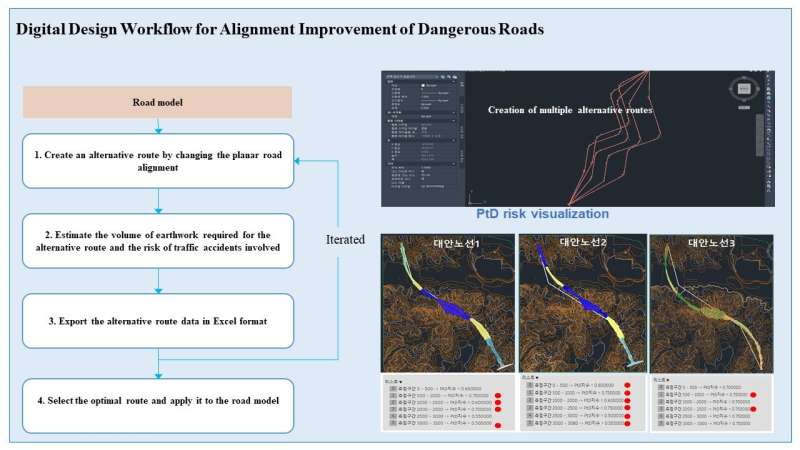
The Korea Institute of Civil Engineering and Building Technology (KICT) developed a digital model designed to identify dangerous roads where traffic accidents frequently occur while further finding optimal measures to improve the safety of such roads, thereby minimizing the risk of traffic accidents.
The Korean Ministry of Land, Infrastructure and Transport, jointly with the country’s local government agencies, has been implementing a project titled the “Alignment Improvement Project for Dangerous National and Provincial Roads” to prevent traffic accidents. This project aims to identify roads with a high risk of major traffic accidents and improve structural hazards found on them, preventing future traffic accidents and enhancing their functionalities as well.
Under this project, dangerous roads are selected based on a combination of various factors, including their geometry, e.g., how the roads curve and slope, the number of traffic accidents, the amount of traffic, regional characteristics, and investment expenditures. Among them, however, geometry is the most significant factor in the scoring system. Simply put, the geometric structure of roads, which determines their overall shape, is considered among the major causes of traffic accidents.
The existing procedure for a feasibility study for the safety improvement of dangerous roads is composed of sequential steps, including traffic accident analysis, dangerous road identification, and improvement measure establishment. Each step is conducted according to the corresponding manual and also in a fragmented manner. Among the steps of this feasibility study, formulating and designing a route plan for a single dangerous road costs about $30,700 (40 million Korean won) and takes a period of more than one and a half months.
Against this backdrop, a research team led by Dr. Hyounseok Moon at KICT’s BIM Research Cluster developed a digital design model to create an optimized linear road model capable of identifying dangerous roads and minimizing the risk of traffic accidents on them.
The developed digital design model employs big data to ensure that dangerous roads are identified and selected in an objective manner, unlike the existing method in which the selection process is conducted in a fragmented manner. Furthermore, this model is capable of creating an optimal digital road model that effectively addresses geometric safety issues found in the selected roads and minimizes the risk of traffic accidents on them.

The developed digital optimization model for dangerous roads was employed to conduct a feasibility study on a single road. Priority determination based on traffic analysis and assessments, followed by the formulation and design of alternative linear routes, all cost about $23,000 (30 million Korean won) and took a period of two to three weeks at the minimum. This means that the developed digital design optimization model for dangerous roads reduces the required cost and period by 30-35% on average.
This research outcome was achieved as follows. First, the Traffic Accident Analysis System (TAAS), a traffic accident big data system provided by KoROAD, was analyzed to identify and select dangerous roads, thereby determining the relationship between geometric factors and the occurrence of traffic accidents.
In doing so, a total of 37,128 traffic accidents (especially fatal ones) that occurred on the country’s national and provincial roads from 2012 to 2020 were analyzed. Among them, 1,138 cases (accounting for 3%) were then selected, which satisfied specific conditions, for example, accidents that occurred on curved roads or inclined roads. From the ones selected above, 77 cases were further selected in which two or more traffic accidents occurred.
These 77 traffic accident cases were considered to have occurred on dangerous roads, and an in-depth examination based on topographic-map and road-view analyses was further conducted on four cases among them.
The digital model developed by KICT was designed to quickly and easily provide multiple optimal alternatives to the selected road design in the form of a 3D model simply by inputting conditions and entering values for variables.
In addition, it can also compare these alternatives in terms of the risk of traffic accidents and the volume of earthwork required, immediately determining whether each of these alternatives satisfies the design requirements. This process allows policymakers to determine which alternative will be the best solution to minimize the risk of traffic accidents.
The distinctive advantage of the developed technology is that it integrates the entire process of decision-making, from the identification of dangerous roads to the generation of optimal alternatives using a digital model; that is, maximizing the efficiency of the process via digital transition.
Dr. Hyounseok Moon said, “This technology developed by KICT can be applied not only to road alignment improvement projects but also to the rapid, digital design of new, safe roads, and it will be widely used as one of the key technologies by combining various ICT solutions, including big data and AI, thereby ushering into the era of digital transformation in the construction industry.”
Provided by
National Research Council of Science & Technology
Citation:
Newly developed digital design workflow for road safety improvement (2023, July 27)
retrieved 27 July 2023
from https://techxplore.com/news/2023-07-newly-digital-workflow-road-safety.html
This document is subject to copyright. Apart from any fair dealing for the purpose of private study or research, no
part may be reproduced without the written permission. The content is provided for information purposes only.
For all the latest Technology News Click Here
For the latest news and updates, follow us on Google News.
